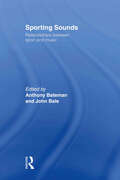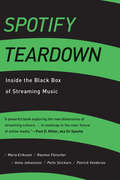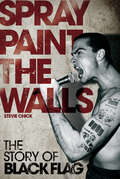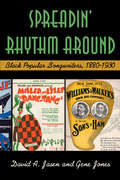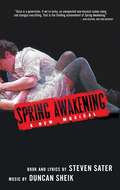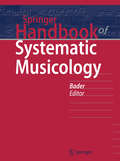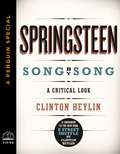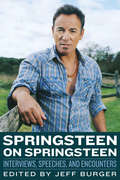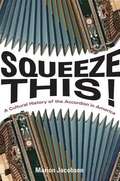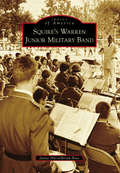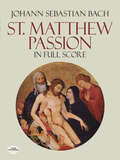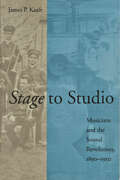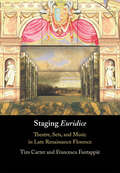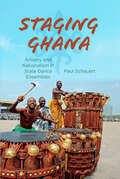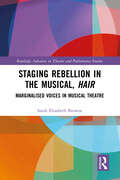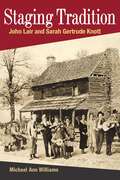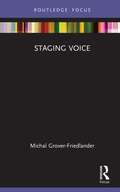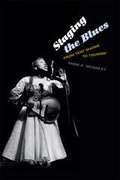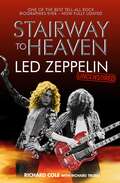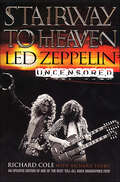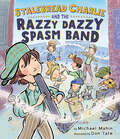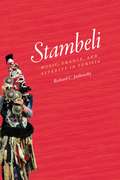- Table View
- List View
Sporting Sounds: Relationships Between Sport and Music
by Anthony Bateman John BaleMusic and sport are both highly significant cultural forms, yet the substantial and longstanding connections between the two have largely been overlooked. Sporting Sounds addresses this oversight in an intriguing and innovative collection of essays. With contributions from leading international psychologists, sociologists, historians, musicologists and specialists in sports and cultural studies, the book illuminates our understanding of the vital part music has played in the performance, reception and commodification of sport. It explores a fascinating range of topics and case studies, including: The use of music to enhance sporting performance Professional applications of music in sport Sporting anthems as historical commemorations Music at the Olympics Supporter rock music in Swedish sport Caribbean cricket and calypso music From local fan cultures to international mega-events, music and sport are inextricably entwined. Sporting Sounds is a stimulating and illuminating read for anybody with an interest in either of these cultural forms.
Spotify Teardown: Inside the Black Box of Streaming Music (The\mit Press Ser.)
by Pelle Snickars Patrick Vonderau Maria Eriksson Anna Johansson Rasmus FleischerAn innovative investigation of the inner workings of Spotify that traces the transformation of audio files into streamed experience.Spotify provides a streaming service that has been welcomed as disrupting the world of music. Yet such disruption always comes at a price. Spotify Teardown contests the tired claim that digital culture thrives on disruption. Borrowing the notion of “teardown” from reverse-engineering processes, in this book a team of five researchers have playfully disassembled Spotify's product and the way it is commonly understood.Spotify has been hailed as the solution to illicit downloading, but it began as a partly illicit enterprise that grew out of the Swedish file-sharing community. Spotify was originally praised as an innovative digital platform but increasingly resembles a media company in need of regulation, raising questions about the ways in which such cultural content as songs, books, and films are now typically made available online.Spotify Teardown combines interviews, participant observations, and other analyses of Spotify's “front end” with experimental, covert investigations of its “back end.” The authors engaged in a series of interventions, which include establishing a record label for research purposes, intercepting network traffic with packet sniffers, and web-scraping corporate materials. The authors' innovative digital methods earned them a stern letter from Spotify accusing them of violating its terms of use; the company later threatened their research funding. Thus, the book itself became an intervention into the ethics and legal frameworks of corporate behavior.
Spotlight on Music, Grade 2
by Carol King Chris Judah-Lauder Ellen Mccullough-Brabson Emily Crocker John Jacobson Judy Bond Margaret Campbelle-Holman Mary Goetze Michael Jothen René Boyer Virginia Ebinger Janet Mcmillion Ivy Rawlins Susan Snyder Vincent Lawrence Betsy Henderson Marilyn Davidson Robert Frece Gilberto Soto Nancy MillerNIMAC-sourced textbook
Spotlight on Music, Grade 4
by Carol King Chris Judah-Lauder Ellen Mccullough-Brabson Emily Crocker John Jacobson Judy Bond Margaret Campbelle-Holman Mary Goetze Michael Jothen René Boyer Virginia Ebinger Janet Mcmillion Ivy Rawlins Susan Snyder Vincent Lawrence Betsy Henderson Marilyn Davidson Robert Frece Gilberto Soto Nancy MillerNIMAC-sourced textbook
Spray Paint the Walls: The Story of Black Flag
by Stevie ChickBlack Flag were the pioneers of American Hardcore, and this is their blood-spattered story. Formed in Hermosa Beach, California, in 1978, they made and played brilliant, ugly, no-holds-barred music for eight brutal years on a self-appointed touring circuit of America's clubs, squats, and community halls. They fought with everybody—the police, the record industry, and even their own fans—and they toured overseas on pennies a day in beat-up trucks and vans. This history tells Black Flag's story from the inside, drawing on exclusive interviews with the group's members, their contemporaries, and the bands they inspired. It depicts the rise of Henry Rollins, the iconic front man, and Greg Ginn, who turned his electronics company into one of the world's most influential independent record labels while leading Black Flag from punk's three-chord frenzy into heavy metal and free jazz.
Spreadin' Rhythm Around: Black Popular Songwriters, 1880-1930
by David A Jasen Gene JonesSpreadin' Rhythm Around: Black Popular Songwriters, 1880-1930 is a classic work on a little-studied subject in American music history: the contribution of African-American songwriters to the world of popular song. Hailed by Publishers Weekly as "thoroughly researched and entertainingly written," this work documents the careers of songwriters like James A. Bland ("Carry Me Back to Ole Virginny"), Bert Williams ("Nobody"), W. C. Handy ("St. Louis Blues"), Noble Sissle, Eubie Blake ("I'm Just Wild About Harry"), and many more. Richly illustrated with rare photographs from sheet music, newspapers, and other unique sources, the book documents an entire era of performance when black singers, dancers, and actors were active on the New York stage.In sheer depth of research, new information, and full coverage, Spreadin' Rhythm Around offers a comprehensive picture of the contributions of black musicians to American popular song. For anyone interested in the history of jazz, pop song, or Broadway, this book will be a revelation.
Spring Awakening
by Steven Sater Duncan Sheik"This brave new musical, haunting and electrifying by turns, restores the mystery, the thrill to that shattering transformation that stirs in all our souls."--Charles Isherwood, The New York Times"The staggering purity of this show will touch all open hearts...In its refined, imaginative simplicity, it daringly reverses all the conventional rules by returning the American musical to an original state of innocence."--John Heilpern, The New York Observer"An unexpected jolt of sudden genius, edgy in its brutally honest, unromanticized depiction of human sexuality."--New York Post Spring Awakening is an extraordinary new rock musical with book and lyrics by Steven Sater and music by Grammy Award-nominated recording artist Duncan Sheik. Inspired by Frank Wedekind's controversial 1891 play about teenage sexuality and society's efforts to control it, the piece seamlessly merges past and present, underscoring the timelessness of adolescent angst and the universality of human passion. Steven Sater's plays include the long-running Carbondale Dreams, Perfect for You, Doll (Rosenthal Prize/Cincinnati Playhouse), Umbrage (Steppenwolf New Play Prize), and a reconceived version of Shakespeare's Tempest, which played in London. Duncan Sheik is a singer/songwriter who also collaborated with Sater on the musical The Nightingale. He has composed original music for The Gold Rooms of Nero and for The Public Theater's Twelfth Night in Central Park.
Springer Handbook of Systematic Musicology (Springer Handbooks)
by Rolf BaderThis unique reference book offers a holistic description of the multifaceted field of systematic musicology, which is the study of music, its production and perception, and its cultural, historical and philosophical background. The seven sections reflect the main topics in this interdisciplinary subject. The first two parts discuss musical acoustics and signal processing, comprehensively describing the mathematical and physical fundamentals of musical sound generation and propagation. The complex interplay of physiology and psychology involved in sound and music perception is covered in the following sections, with a particular focus on psychoacoustics and the recently evolved research on embodied music cognition. In addition, a huge variety of technical applications for professional training, music composition and consumer electronics are presented. A section on music ethnology completes this comprehensive handbook. Music theory and philosophy of music are imbedded throughout. Carefully edited and written by internationally respected experts, it is an invaluable reference resource for professionals and graduate students alike.
Springsteen Song by Song
by Clinton HeylinAcclaimed music writer Clinton Heylin's revelatory biography E Street Shuffle charts the rise of Bruce Springsteen and his legendary E Street Band in intimate detail, from their blue-collar New Jersey roots to the heights of rock stardom. Now, in Springsteen Song by Song, Heylin culls studio data, demo tracks, and his own extensive knowledge to offer insights, history, and critical commentary on 300 songs recorded by the Boss between 1972 and 1984. These concise yet insightful notes are essential reading for Springsteen true believers as well as fans just beginning to discover the early work of this living American legend.
Springsteen on Springsteen: Interviews, Speeches, and Encounters (Musicians in Their Own Words)
by Jeff BurgerOffering fans an extensive look at the artist's own words throughout the past four decades, Springsteen on Springsteen brings together Q & A-formatted articles, speeches, and features that incorporate significant interview material. No one is better qualified to talk about Springsteen than the man himself, and he's often as articulate and provocative in interviews and speeches as he is emotive onstage and in recordings. While many rock artists seem to suffer through interviews, Springsteen has welcomed them as an opportunity to speak openly, thoughtfully, and in great detail about his music and life. This volume starts with his humble beginnings in 1973 as a struggling artist and follows him up to the present, as Springsteen has achieved almost unimaginable wealth and worldwide fame. Included are feature interviews with well-known media figures, including Charlie Rose, Ted Koppel, Brian Williams, Nick Hornby, and Ed Norton. Fans will also discover hidden gems from small and international outlets, in addition to radio and TV interviews that have not previously appeared in print. This is a must have for any Springsteen fan.
Squeeze This!: A Cultural History of the Accordion in America
by Marion JacobsonThe piano accordion experienced a roller coaster ride of popularity--rise to fame on the airwaves, stage and silver screen, then a deathly decline, followed by a pop culture resurgence. Squeeze This! rolls out a history of the squeezebox with the first book-length study of its fascinating role in twentieth-century American music and culture. Focusing on key moments of transition, ethnomusicologist and accordion enthusiast Marion Jacobson shows how the instrument came to be celebrated by ethnic musical communities and mainstream fans alike. She also explores the accordion's rebirth in contemporary music, from the parodies of "Weird Al" Yankovic to geek rock legends They Might Be Giants to accordion-wielding superstars like Bruce Springsteen and Sheryl Crow. Loaded with images of gorgeous instruments, virtuoso performers, and rabid fans, Squeeze This! presents the untold story of America's rich accordion culture.
Squire's Warren Junior Military Band (Images of America)
by Janne Hurrelbrink-BiasSquire�s Warren Junior Military Band had an emotional appeal that endeared it to audiences of all ages. Considered one of northeastern Ohio�s richest artistic assets, the band�s members, who hailed from the entire region, were filled with pride, tradition, patriotism, and a sense of discipline. The original VFW Boys Band was formed in 1927, with Donald W. �Squire� Hurrelbrink becoming director in 1930. In 1957, the name changed to the Warren Junior Military Band. Travels took the band from the East Coast to the West Coast, from Canada to the Gulf of Mexico, and to audiences abroad, amassing an impressive record of Midwest, Canadian, European, American Legion, and VFW National Championships. Throughout the years, the band performed at numerous prestigious events and for an impressive number of dignitaries, as well as a phenomenal number of local, civic, and patriotic festivities. Members were privileged to have Squire�s leadership for 66 years. Alumni continued to lead, direct, and pass on the values they learned under Squire�s guidance. Finally, in 2010, the band ended its long legacy.
St. Louis Jazz: A History
by Dennis C OwsleyExplore the history of the artists who contributed to the Gateway City&’s jazz scene and the world of music.In the early twentieth century, St. Louis was a hotbed for ragtime and blues, both roots of jazz music. In 1914, Jelly Roll Morton brought his music to the area. In 1919, Louis Armstrong came to town to play on the &“floating conservatories&” that plied the Mississippi. Miles Davis, the most famous of the city&’s jazz natives, changed the course of the genre four different times throughout a world-renowned career. The Black Artists Group of the 1970s was one of the first to bring world music practices into jazz. Author Dennis C. Owsley chronicles the ways both local and national St. Louis musicians have contributed to the city and to the world of music.
St. Matthew Passion: In Full Score
by Johann Sebastian BachOne of the most performed and recorded of Bach's major works, the St. Matthew Passion has been a focal point of concert seasons and festivals around the world for over 150 years. First performed in the late 1720s, it is a drama of epic grandeur, long considered the noblest, most inspired musical treatment of the story of the crucifixion of Christ. Bach set the text, based on two chapters from the Gospel of St. Matthew, using a large ensemble of two choruses, soloists, and two orchestras. The full score is reprinted here from the fine edition prepared by the Bach-Gesellschaft.Although the St. Matthew Passion is often held to be the apotheosis of Lutheran church music, this magnificent oratorio reaches out to its audience in the language, form, and spirit of opera. Richly dramatic and theatrical, following the general form of Baroque opera, it unfolds its deeply moving story in recitatives, ariosos, arias, chorales, and mighty choral movements. This finely produced score offers music lovers the opportunity -- at a price far lower than comparable editions -- to follow performances score in hand, and to gain a more intimate knowledge of the rich musical textures of this great masterwork.
Stage to Studio: Musicians and the Sound Revolution, 1890-1950 (Studies in Industry and Society #9)
by James P. KraftAward for Best Research in the Field of Record Labels or Manufacturers from the Association for Recorded Sound CollectionsWinner of the Kenneth W. Baldridge Prize from the Phi Alpha Theta Honor Society, Hawaii Region Between the late nineteenth and mid-twentieth century, technology transformed the entertainment industry as much as it did such heavy industries as coal and steel. Among those most directly affected were musicians, who had to adapt to successive inventions and refinements in audio technology—from wax cylinders and gramophones to radio and sound films. In this groundbreaking study, James P. Kraft explores the intersection of sound technology, corporate power, and artistic labor during this disruptive period.Kraft begins in the late nineteenth century's "golden age" of musicians, when demand for skilled instrumentalists often exceeded supply, analyzing the conflicts in concert halls, nightclubs, recording studios, radio stations, and Hollywood studios as musicians began to compete not only against their local counterparts but also against highly skilled workers in national "entertainment factories." Kraft offers an illuminating case study in the impact of technology on industry and society—and a provocative chapter in the cultural history of America.
Staging 'Euridice': Theatre, Sets, and Music in Late Renaissance Florence
by Tim Carter Francesca FantappièEuridice was one of several music-theatrical works commissioned to celebrate the wedding of Maria de' Medici and King Henri IV of France in Florence in October 1600. As the first 'opera' to survive complete, it has been viewed as a landmark work, but its libretto by Ottavio Rinuccini and music by Jacopo Peri and Giulio Caccini have tended to be studied in the abstract rather than as something to be performed in a specific time and place. Staging “Euridice” explores how newly-discovered documents can be used to precisely reconstruct every aspect of its original stage and sets in the room for which it was intended in the Palazzo Pitti. By also taking into account what the singers and instrumentalists did, what the audience saw and heard, and how things changed from creation through rehearsals to performance, this book brings new aspects of Euridice to light in startling ways.
Staging Ghana: Artistry And Nationalism In State Dance Ensembles (Ethnomusicology Multimedia)
by Paul SchauertThe Ghana Dance Ensemble takes Ghana's national culture and interprets it in performance using authentic dance forms adapted for local or foreign audiences. Often, says Paul Schauert, the aims of the ensemble and the aims of the individual performers work in opposition. Schauert discusses the history of the dance troupe and its role in Ghana's post-independence nation-building strategy and illustrates how the nation's culture makes its way onto the stage. He argues that as dancers negotiate the terrain of what is or is not authentic, they also find ways to express their personal aspirations, discovering, within the framework of nationalism or collective identity, that there is considerable room to reform national ideals through individual virtuosity.
Staging Rebellion in the Musical, Hair: Marginalised Voices in Musical Theatre (Routledge Advances in Theatre & Performance Studies)
by Sarah Elisabeth BrowneThis volume provides a comprehensive survey of the musical Hair and will offer critical analysis which focuses on giving voice to those who are historically considered to be on the margins of musical theatre history. Sarah Browne interrogates key scenes from the musical which will seek to identify the relationship between performance and the cultural moment. Whilst it is widely acknowledged that Hair is a product of the sixties counter-culture, this study will place the analysis in its socio-historical context to specifically reveal American values towards race, gender, and adolescence. In arguing that Hair is a rebellion against the established normative values of both American society and the art form of the musical itself, this book will suggest ways in which Hair can be considered utopian: not only as a utopian ‘text’ but in the practices and values it embodies, and the emotions it generates in its audiences. This book will be of great interest to scholars and students of music, musical theatre, popular music, American studies, film studies, gender studies, or African American studies.
Staging Tradition: John Lair and Sarah Gertrude Knott (Music in American Life)
by Michael Ann WilliamsBased on extensive archival research and oral history, Staging Tradition traces the parallel careers of the creators of the Renfro Valley Barn Dance and the National Folk Festival. Through their devotion to the staging of traditional culture, including folk, country, and bluegrass music, John Lair (1894-1985) and Sarah Gertrude Knott (1895-1984) became two of the mid-twentieth century's most notable producers. Lair and Knott's discovery of new developments in theater and entertainment during the 1920s led the pair to careers that kept each of them center stage. Inspired by programs such as WLS's Barn Dance and the success of early folk events, Lair promoted Kentucky musicians. Knott staged her own radically inclusive festival, which included Native and African American traditions and continues today as the National Folk Festival. Michael Ann Williams shows how Lair and Knott fed the public's fascination with the "art of the common man" and were in turn buffeted by cultural forces that developed around and beyond them.
Staging Voice (Routledge Voice Studies)
by Michal Grover-FriedlanderStaging Voice is a unique approach to the aesthetics of voice and its staging in performance. This study reflects on what it would mean to take opera’s decisive attribute—voice—as the foundation of its staged performance. The book thinks of staging through the medium of voice. It is a nuances exploration, which brings together scholarly and directorial interpretations, and engages in detail with less frequently performed works of major and influential 20th-century artists—Erik Satie, Bertolt Brecht and Kurt Weill—as well as exposes readers to an innovative experimental work of Evelyn Ficarra and Valerie Whittington. The study is intertwined throughout with the author’s staging of the works accessible online. This book will be of great interest to students and scholars in voice studies, opera, music theatre, musicology, directing, performance studies, practice-based research, theatre, visual art, stage design, and cultural studies.
Staging the Blues: From Tent Shows to Tourism
by Paige A. McginleySinging was just one element of blues performance in the early twentieth century. Ma Rainey, Bessie Smith, and other classic blues singers also tapped, joked, and flaunted extravagant costumes on tent show and black vaudeville stages. The press even described these women as "actresses" long before they achieved worldwide fame for their musical recordings. In Staging the Blues, Paige A. McGinley shows that even though folklorists, record producers, and festival promoters set the theatricality of early blues aside in favor of notions of authenticity, it remained creatively vibrant throughout the twentieth century. Highlighting performances by Rainey, Smith, Lead Belly, Sister Rosetta Tharpe, Sonny Terry, and Brownie McGhee in small Mississippi towns, Harlem theaters, and the industrial British North, this pioneering study foregrounds virtuoso blues artists who used the conventions of the theater, including dance, comedy, and costume, to stage black mobility, to challenge narratives of racial authenticity, and to fight for racial and economic justice.
Stairway To Heaven
by Richard ColeThe most powerful, popular and enduring rock band of all time, the excitement of Led Zeppelin's music was matched only by the fever pitch of their off-stage antics. In hotel rooms and stadiums, in a customized private Boeing 707 jet and country estates, tour manager Richard Cole saw it all - and here tells it all in this close-up, down-and-dirty, no-holds-barred account. This revised edition brings readers up to date on the lives and careers of the band members, whose wild excesses, bizarre lifestyles and ground-breaking music are now the stuff of legend.
Stairway To Heaven: Led Zeppelin Uncensored
by Richard Cole Richard TruboThis account of Led Zeppelin’s decadent life on the road by their longtime tour manager “dishes up the real dirt as only an insider’s report can” (Kirkus Reviews).No one knew Led Zeppelin like Richard Cole. The band’s tour manager for more than a decade, Cole was there when they burst onto the music scene, achieved cult status, cut platinum records, and transformed popular music. Second only to the Beatles in sales for years, Led Zeppelin was rock’s premier group. But unlike the boys from Liverpool, the excitement of this band’s music was matched by the fever pitch of their antics on and off the stage.In hotel rooms and stadiums, in a customized private Boeing 707 jet and country estates, Richard Cole saw it all—and tells it all in this close-up, down-and-dirty, no-holds-barred account that records the highs, the lows, and the occasional in-betweens. This revised edition includes updates on the band members’ lives and careers, which may be a little quieter now, but their songs remain the same.
Stalebread Charlie and the Razzy Dazzy Spasm Band
by Michael MahinBased on a true story, a vibrant, inspirational picture book about self-reliance and the power of creativity and music, in which a group of hungry homeless kids in 19th century New Orleans build their own musical instruments from discarded items and become a successful band. It's 1895, and ten-year-old Stalebread Charlie and his friend Warm Gravy roam the streets of New Orleans, homeless and hungry. Stalebread has heard folks say that music feeds the soul—and he wonders if it could also fill their bellies. Soon he and his friends are playing instruments made out of junk—a fiddle from a cigar box, a kazoo from a comb—until their hats are filled with coins, their bellies are filled with beignets, and their souls are filled with music. This inspiring make-lemonade-from-lemons tale includes author/illustrator notes about the real Stalebread and the research behind the book and a make-your-own-instrument activity.
Stambeli: Music, Trance, and Alterity in Tunisia (Chicago Studies in Ethnomusicology)
by Richard C. JankowskyIn Stambeli, Richard C. Jankowsky presents a vivid ethnographic account of the healing trance music created by the descendants of sub-Saharan slaves brought to Tunisia during the eighteenth and nineteenth centuries. Stambeli music calls upon an elaborate pantheon of sub-Saharan spirits and North African Muslim saints to heal humans through ritualized trance. Based on nearly two years of participation in the musical, ritual, and social worlds of stambeli musicians, Jankowsky’s study explores the way the music evokes the cross-cultural, migratory past of its originators and their encounters with the Arab-Islamic world in which they found themselves. Stambeli, Jankowsky avers, is thoroughly marked by a sense of otherness—the healing spirits, the founding musicians, and the instruments mostly come from outside Tunisia—which creates a unique space for profoundly meaningful interactions between sub-Saharan and North African people, beliefs, histories, and aesthetics. Part ethnography, part history of the complex relationship between Tunisia’s Arab and sub-Saharan populations, Stambeli will be welcomed by scholars and students of ethnomusicology, anthropology, African studies, and religion.
